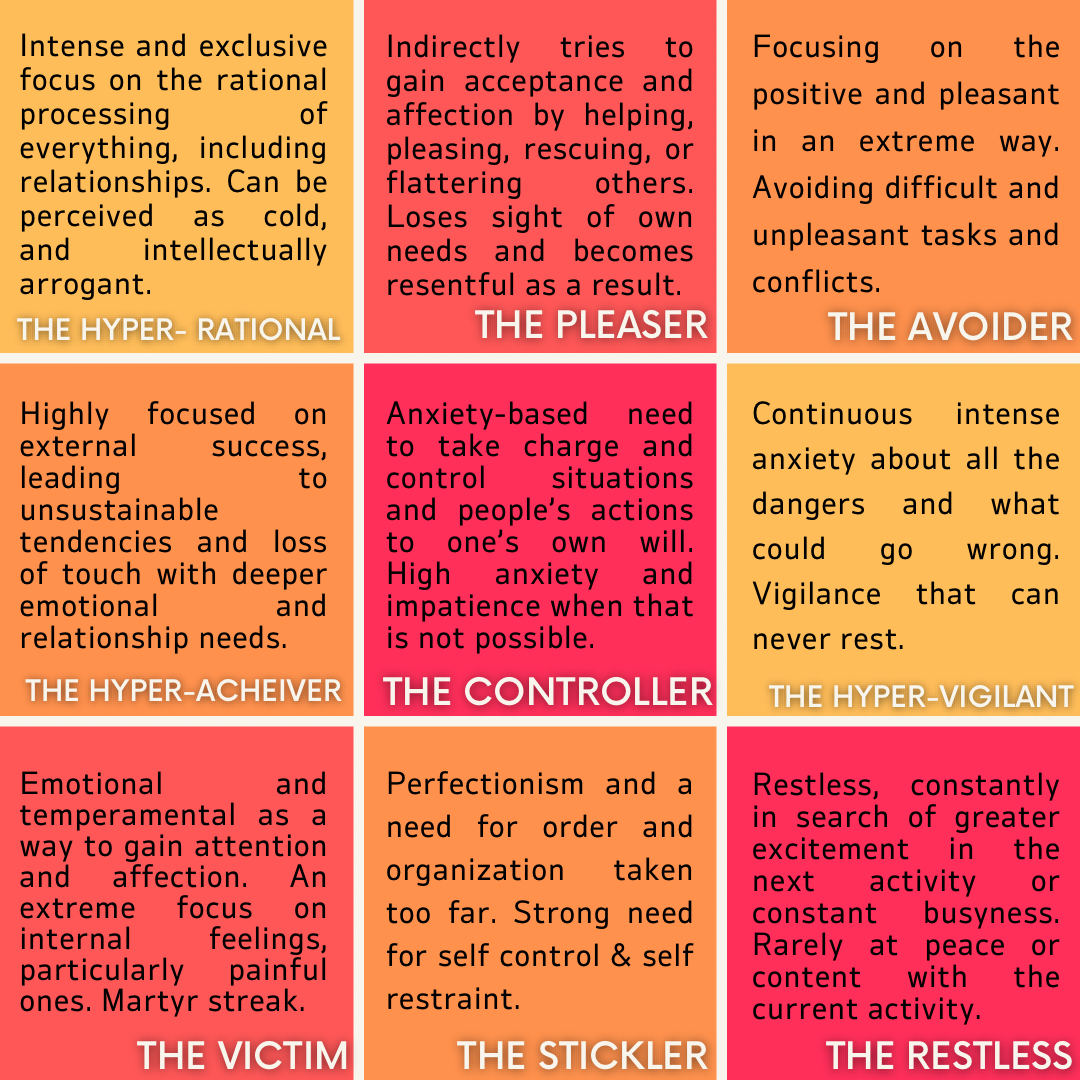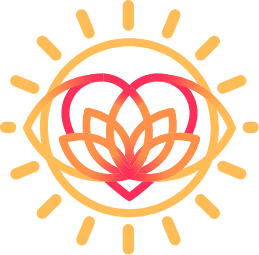Coaching Skills for Leaders
Train to Coach: Practical Coaching Skills for School Leaders
Virtual Training
15th May – 9:00 - 12:00
19th June – 12:00 - 3:00
Join our half-day virtual training designed specifically for headteachers and senior leaders
Who is this for?
• Headteachers, Senior and Middle Leaders, SENCOs, and anyone with a responsibility for line managing or supporting colleagues
• Those looking to develop their own coaching skills and shift from a mentoring mindset to a coaching mindset
• Leaders who want to empower their staff to take ownership of problem-solving, reducing dependency on the headteacher for every challenge
What are the benefits?
• An Effective Coaching Framework – Learn a structured, time-efficient model rooted in positive psychology and radical candour. Use it for 1:1 coaching, SLT meetings, appraisals, and difficult conversations.
• Confidence in Holding Coaching Conversations – Create a judgement-free, accountable space where staff can explore challenges and solutions.
• Fostering Self-Awareness and Change – Develop a coaching culture where individuals own their growth, resulting in more independent, empowered staff.
• Tackling Challenges Head-On – Move away from avoidance and learn how to address issues constructively.
• Practical, Interactive Learning – Experience coaching in action through hands-on practice using the LEGO® Serious Play methodology.
What to Expect
• Virtual, group-based, interactive, and practice-focused
• Half a day – morning or afternoon sessions available
• £300 per person, or £275 per person when booking two or more places from the same school
• Includes your own step-by-step coaching guide to use in your school
• Available for leadership teams and school staff INSET/Twilight – ask for a quote
Meet Your Trainer
Kate is a former headteacher and ICF ACC-accredited coach who has supported over 4,000 school leaders through coaching and facilitation. She specialises in intentional well-being, leadership transitions, and communication coaching to help leaders thrive in their roles.
Kate@headsup4hts.co.uk

The Creative Learning Award (LBU) A conversation with co-creators Kate and Lisa
Kate and Lisa are the Co-Creators of the Leeds Beckett University Creative Learning and Ethical Citizenship Award for Schools. Here, they introduce what the award entails, why it is relevant now, and the process of co-creating an award that aims to support schools in reimagining their curriculum using creativity and ethical citizenship as a driver.
Kate and Lisa, tell us a bit about who you are and what you do:
Lisa: I’m passionate about the creative arts as a way of connecting and empowering diverse communities of learners! I’m a researcher and lecturer in Initial Teacher Education and Creative Learning at Leeds Beckett University. My practice based research focuses on story making with children to create culturally relevant curriculum opportunities. This centres on active participation, compassion, critical thinking and wellbeing which is the foundation for an Ethical Curriculum- both locally and globally.
I have worked in education for 25 years, as a teacher and senior leader in Primary Schools in Bradford. I am also an experienced drama practitioner working in community arts. I am Director and founder of Story Makers Company, a practice based research collaborative. Our research and practice develops creative learning opportunities with schools and cultural organisations both nationally and internationally.
Kate: I’m a freelance coach and compassionate leader who is dedicated to the development of an Ethical Curriculum: a curriculum that interweaves relevant moral and social themes such as equity & diversity, global citizenship and sustainable living into the education system. This, and supporting others to be the best they can be through coaching and sustainable support, is my soul mission!
I have worked in education for 15 years, most recently as the Co- Headteacher of a Primary School in Oxfordshire. I am also the Network Project Leader for an incredible National Headteachers Network called HeadsUp4HTs which champions the role of headship and provides sustainable emotional support to Headteachers and school leaders across the UK.
What was it that initiated the creation of the Creative Learning & Ethical Citizenship Award?
Kate: As a school leader, I was always driven to design a more relevant, purposeful and ethical curriculum than the one the National Curriculum prescribed. A curriculum that ensured all pupils developed holistically; allowing them to deeply understand, celebrate and empathise with others, empowering them to become global citizens, changing their attitudes and actions to make the world a kinder, more sustainable place to live.
There’s a demand for a curriculum that focuses on learning and enjoyment beyond exams, one that’s ethically informed and develops the skills that students themselves need to thrive in the future.
Lisa: I share Kate’s vision for creating the award. My rationale for creating this award is also driven by the communities of educators and children with whom I work as well as my own practice. As a practitioner researcher, I have been involved in researching with and alongside children, teachers and artists through many projects. This always includes multiple perspectives and ways of knowing. A pattern emerges through these experiences when children often critically reflect on their own perceptions of learning. This includes a greater sense of participation, belonging, emotional literacy and agency.
Within most creative learning contexts, children need to find solutions which are not in textbooks. They need to work as a diverse community of thinkers. This involves taking risks and embracing uncertainty. This type of generative thinking is critical in facing future learning needs as we strive to create a more sustainable world. The award is designed to facilitate a community of practice amongst educators in developing and sharing an ethical curriculum driven by creative learning.
Why is it needed now?
Lisa: Young people are facing many challenges such as climate change, technological advancements and social divides. This raises the question of what knowledge should be taught and why, in order to equip children to thrive in the future. In a sense, Educational Policy has not developed in line with these needs and many children feel that learning is disconnected from their lived experiences. There are some really innovative curriculum models in schools and school leaders in response to these needs and their community of learners. The award creates a space to create, rethink and share a more sustainable curriculum model together in response to the world that we live in.
Kate: There’s been a lot of discussion about the value of what is being taught, learned and measured in schools during the pandemic. In a sense, this time has given school leaders the freedom to focus on what their children and communities need, without the restraints of performing for OFSTED. It’s given schools a taste of what could and should be in a new version of education! School leaders are keen to reimagine their curriculum now, to ensure they are not only preparing children for the future, but also thinking about a more sustainable lifestyle in terms of mental, physical health and taking care of the planet.
Tell us about the creative process of co- creating an award for schools:
Kate: As an advocate for co-working, and as a former co-headteacher and co- deputy headteacher, it’s been an absolute pleasure to collaborate with Lisa and Rachel on this award! It’s interesting because we all have a different perspectives and understandings around what creativity is and looks like and we had much deliberation of the title of the award! From my perspective as a former teacher and primary Headteacher, creativity is learning about the arts and cultural curriculum, and having the freedom and expertise to develop artistic skills and practice to a high standard, such as dance, drama, story telling, drawing and sculpting. These are the magical aspects of the curriculum that the children love! Lisa taught me about creativity from a different perspective through her lens in FE and as a researcher. We all wanted the framework and standards for the award to support schools to develop and celebrate their incredible work.
Lisa: The most powerful work is always collaborative- it draws from the strengths of the group. This award draws from the professional expertise in education from all of us. This type of thinking always promotes critical reflection, active listening and reimagining- which is why we feel that it is so important as part of the curriculum! It has been exciting to draw from our shared practice as this award has emerged over the past year. Kate’s perspective on school leadership and curriculum design has been a critical part of the award as has Rachel’s enterprise expertise and award design. We are currently piloting the award in schools and the Headteachers and teachers feedback will further shape our framework. As well as providing sustained support for schools, we see the award as becoming a celebration of curriculum values and the teacher’ professional imagination!
What does this award mean for you?
Lisa: All teachers want to equip children to thrive in a world in which they feel valued and can actively participate. This means a refocusing on our relationship with the world and each other- a more balanced curriculum. I believe that the award will nurture this curriculum space. This includes learning with and in response to each other as a community of practice. It advocates that teachers and schools know their pupils best and that the framework supports, connects and invigorates collective thinking. A recent report by the Cultural Alliance (2019) cited many children’s lack of opportunities to engage in cultural activity as a social justice issue. The creative arts have a unique relationship with the world providing a universal and global language through images, movement and sound which help us to make connections between ourselves and others. This curriculum means empowering children as critical thinkers to gain more confidence in acting ethically together in the world.
The award means that we have a shared reflective space to reimagine curriculum together. The time to act is now!
Kate: The future of education needs courageous teachers and school leaders to teach a reimagined curriculum! I want to ensure that we are teaching a diverse and colourful curriculum that promotes equity and inclusion for all. We want to be educating our young people on issues around sustainable living, and the importance of becoming globally minded citizens in order to make the world sustainable; a kinder and more equitable place. We want our young people to know and live their core values, to know their purpose in the world, so deeply, that they develop an authentic self esteem with the potential to become future change makers. I believe this award will give schools a robust framework to work within in order to start making a real impact on the educational landscape.
Who is this award for?
Lisa: This award is for headteachers, teachers, parents and children who all need to see themselves as agents of change. It involves a systematic approach to coaching which draws from innovative curriculum models and empirical research in schools. This means that there are many professional development opportunities. The flexible nature of the award also means that it can be applied to the time frames of individual schools. The award aims to support teachers and pupils to create a culturally relevant curriculum that promotes and encourages critical and generative thinking. It offers an opportunity to draw from international perspectives on ethical curriculum and think beyond examinations.
Kate: I work with a large network of Headteachers so I know there is a demand for a focus on a more ethical curriculum from a school leaders perspective. And, from a students perspective, there is a demand for more opportunities to develop skills and values that will serve them beyond their exams. This award is for anyone with a desire to give their students an opportunity to make a lasting impact on themselves and their communities, and learn about the value of citizenship and creativity in the process. As the school lead on the award, there are great professional development opportunities available too, through transforming practice to make sustainable changes, developing creative pedagogy and understanding and creating community through ethical and creative arts practice.
Creative Learning: Ethical Citizenship Award has been designed to facilitate an ethical curriculum in school. The award supports leaders and teams in schools and other educational settings, to develop a whole school culture of creative learning and ethical citizenship through the art.
Using a developmental framework schools will evaluate their current creative teaching practices and pedagogy, identify gaps, develop, and strengthen these and work towards a commitment to creative learning for their whole school community.
The award recognises the value that a creative learning community can have for both staff and pupils and the benefits and impact that the arts, culture, and creativity can have in developing meaningful and relevant learning opportunities for inclusion, sustainable thinking and the positive wellbeing of young people in 21st Century learning.
For more information and to sign up for he award please visit:
https://www.storymakersco.com/creative-learning-award
https://www.leedsbeckett.ac.uk/carnegie-school-of-education/professional-development/
Decision Fatigue
As a headteacher, you’re used to making decisions all day long—big ones, small ones, and everything in between. But sometimes, the smallest question can feel like the heaviest weight. I remember being asked, “Should we order the blue books or the orange books?” It was such a simple, inconsequential choice, but at that moment, I wanted to tear my hair out. It wasn’t really about the books. It was about the sheer volume of decisions I had already made that day—and the emotional toll they were taking.
That seemingly trivial question was the straw that could have broke the camel’s back. It wasn’t just about the decision itself but the weight of constantly having to decide everything for everyone.
The Emotional Weight of Decisions
Decision-making isn’t just a cognitive process—it’s an emotional one. As leaders, we carry the responsibility of ensuring our choices align with the needs of our staff, students, parents, and the wider school community. Even the smallest decisions chip away at our mental energy, and over time, they add up.
The emotional toll comes from the knowledge that:
• Every choice feels significant: Even small decisions can have a ripple effect on your team or your school.
• You’re the go-to person: When everyone depends on you, it’s hard to say, “I don’t know” or delegate effectively.
• There’s rarely a break: From the moment you wake up to the end of the school day (and beyond), decision-making is relentless.
It’s no wonder that by the time we’re asked something minor, like “blue or orange,” it feels utterly overwhelming.
A Reflective Exercise for Decision Awareness
One of the most powerful exercises I use as a well-being coach is to help clients uncover just how much energy goes into decision-making—often without them realising it. Here’s how it works:
1. Write Down Your Decisions
I ask clients to journal every decision they can recall making that day. It could be as small as choosing what to wear or as significant as approving a school-wide policy.
2. Rate the Decisions
Next, we categorise them:
• How much gravitas did each decision carry? Was it life-altering, or could it have been delegated?
• How much importance did it have in the grand scheme of things?
3. Reflect on the Insights
The exercise often reveals that a significant amount of energy is spent on low-gravitas, low-importance decisions. These could easily be delegated, automated, or even ignored.
Through this process, headteachers can visualise the mental load they carry and identify opportunities to focus their energy on decisions that truly matter.
How to Lighten the Load
If you feel like the “blue or orange books” question is your breaking point, here are some strategies to help:
1. Create Decision Filters
Develop simple frameworks or policies for recurring decisions. For example: “All exercise books will be blue unless there’s a compelling reason otherwise.” This eliminates the need for trivial choices.
2. Delegate with Clarity
Trust your team to make more decisions. Be clear about their responsibilities and empower them to take ownership of certain tasks.
3. Journal to Reclaim Perspective
Use the journalling exercise to track your decisions and reflect on the balance between low-importance and high-importance choices. Over time, this practice will help you refocus your energy.
4. Say “No” or “Not Now”
Every decision you make takes time and energy. Don’t be afraid to decline non-essential tasks or ask someone to return later with a clear proposal.
5. Prioritise Your Well-Being
Decision fatigue is a sign that you’re running on empty. Regular breaks, mindfulness, and self-care practices will help you replenish your reserves.
A Final Thought
The next time a seemingly minor question makes you want to scream, remember: it’s not the question—it’s the cumulative weight of being the decision-maker for everyone, every day. By becoming more aware of your decision-making patterns and learning to delegate or simplify where you can, you’ll not only reduce decision fatigue but also create space for the decisions that truly matter.
If you’re feeling overwhelmed, know that you’re not alone—and there’s always a way forward. Start small, reflect often, and give yourself the permission to let go of what doesn’t need your energy.
Emotional Spirals
As a well-being coach for headteachers, I see how easily one challenging moment can throw us off balance. A tough meeting, an unexpected complaint, or a critical email can leave us unsettled. Then, as the day progresses, it seems like everything conspires to test our patience. We start anticipating more bad news, overanalysing emails, and ruminating on conversations with a growing sense of unease.
Emotional spirals, whether triggered by stress or overwhelm, have their own momentum. When we’re caught in one, they distort our thinking and drive behaviours that make the situation worse. For headteachers, this might look like withdrawing from your team, replaying difficult conversations in your mind, isolating yourself from support, or sacrificing movement and exercise in the name of “getting on top of things.” While working through the to do list may feel like the easiest or most comfortable option at the time, this can deepen feelings of anxiety, disconnection and exhaustion.
The key to breaking a downward spiral often lies in doing the opposite of what instinct tells us. It requires us to reach out for connection, engage in movement, or reframe our perspective—actions that feel difficult in the moment but create a much-needed disruption.
Last week, I found myself completely overwhelmed. Life felt like a never-ending to-do list: sorting out the ULEZ charges, tackling banking and broadband issues, managing my kids’ emotional ups and downs, meeting a book deadline, balancing a busy coaching workload, and launching an app—all while feeling drained and desperate for a break despite only just having half term!
I felt stuck. My mind kept cycling through all the things that were going wrong, fixating on the negatives. The more I focused on what wasn’t working and what I had left to do, the harder it felt to make any progress. It was like being caught in a downward spiral—mentally and emotionally trapped.
Even as a well-being coach, fully aware of the steps I needed to take—steps I regularly guide others through—I found myself so entangled in my own thoughts and resistance that it felt easier to surrender to the chaos of my disoriented state. What started to help me climb out wasn’t a dramatic fix or an overnight shift. I often tell my clients that i believe a positive experience can help to heal a negative one, and so I knew to look to change things up. As much as I felt like staying at home for the weekend, I booked a train, a hotel room and a pair of cinema tickets. I had committed myself to leaving the house, the life admin and the laundry behind. The first step out of the spiral was small, It began with a small step: changing my environment, booking a weekend away, and later, opening up to a trusted friend. Talking it through with someone who really listened helped me realise how trapped I’d been in my own head. I’d been ruminating on trivial problems and losing sight of the bigger picture.
The thing about emotional spirals is that they feed on themselves. When we’re in a downward one, it’s easy to feel powerless and stuck because our thoughts and actions reinforce that feeling. I’d been withdrawing, avoiding moments of connection, and trying to push through without taking care of myself as well as I could have been.
But here’s the key: to break free, we often have to do the opposite of what we feel like doing. For me, that meant stepping outside my routine, reaching out for trusted support, and prioritising something restorative.
The good news is that positive actions, no matter how small, have their own momentum too. That weekend away broke my cycle of negativity. I was able to step back, breathe, and notice what was still good in my life. I started to feel lighter, more open to solutions, and more attuned to the positive moments around me. I could see opportunities where before I’d only seen problems. My train this morning was cancelled, but instead of it being the straw that broke the camel’s back, I embraced it. I’ve got two extra hours in London today so I’ll go and check out an exhibition at a gallery.
This is an example of what researchers call “upward spirals.” Positive emotions, even brief ones, broaden our perspective and open us up to new possibilities. They don’t magically erase our challenges, but they make us more resourceful and resilient in how we approach them. Instead of feeling stuck in survival mode, we start to thrive.
The beauty of upward spirals is that one small shift can ripple outward, creating a chain reaction. For me, my weekend away helped me reconnect with joy, creativity, and purpose. It didn’t solve all my problems, but it gave me the energy and perspective to face them in a better frame of mind.
So if you find yourself stuck in a downward spiral, remember: even the smallest positive action can set you on a better path. Step outside your usual routine, connect with someone you trust, or try something that shifts your perspective. It might feel hard in the moment, but it’s the first step towards something better. Sometimes, all we need is a little momentum to turn things around. If you’d like coaching to help you out of a downward spiral, get in touch.
Feeling overwhelmed? Try Eating a Frog 🐸
🤡 Plate spinning
🤹♂️ Juggling balls
🐹 Hamster wheel...
You’d be forgiven for thinking I work in the circus, but these are the phrases that I hear over and over to describe the relentlessness of leading a school. As an ex-procrastinator with restless and pleaser saboteurs, I know how overwhelming the never ending to do lists can feel. My work as a wellbeing coach involves helping people to find the strategies that work for them, to improve their sense of self and control. In this blog, I want to introduce the ‘Eat the Frog’ methodology, a simple yet powerful approach to productivity, even if you’re a pro procrastinator! This technique provides tools to tackle the least appealing tasks with confidence, helping you navigate the never-ending to-do list and drastically reduce anxiety and overwhelm.
Below, I’ve broken the method down into actionable steps, specifically with your wellbeing in mind:
Step 1: Identify and Prepare to Eat Your Frog
The "frog" represents your most daunting and important task of the day. This is the task that, if completed, will have the most significant impact on your wellbeing and outcomes at work. As a leader, it could be a crucial strategic decision, a difficult conversation with a team member, or writing a response to a particularly challenging parent. It is nearly always something you don’t want to do!
When to identify the frog?
At the end of each workday, spend a few minutes identifying your frog for the next day. A frog is always an ‘important-urgent’ task and will often have serious consequences if it’s not completed. Consider your levels of anxiety and overwhelm a serious consequence! If you know you’ll alleviate those feelings by completing the task, then the task is a frog. You might think, "but everything is an important-urgent task!" While this might feel true, prioritise your frogs, as this helps bring perspective. Frogs can’t wait (there’s an immediate consequence), whereas other tasks (tadpoles) can.
Outline the steps required to tackle your frog. Break it down into manageable chunks if it feels overwhelming and set up your workspace the night before. Consider setting boundaries (e.g., an out-of-office message, a sign on your door, or informing your SBM that you’re not available between x and y) to reduce in-person and digital distractions. Consider what resources you need to complete the tasks and get them ready.
Step 2: Eating the Frog
Morning is the ideal time to address your most important task because you are typically more focused and have higher energy levels. Make sure you’ve fuelled yourself with breakfast (and coffee if you’re like me!)
Begin working on your frog as soon as you start your workday. Avoid checking emails or social media until you've made significant progress—using the Pomodoro method may help if, like me, you find yourself checking emails/WhatsApp without realising you’ve come off task. Eliminate distractions: turn off notifications, hide your phone, close unnecessary tabs, and let your team know you need some uninterrupted time.
If you need a break from eating your frog, that’s okay—frogs are meaty tasks! Allow yourself to get out of the office, change the scene, get some fresh air, or if that’s not possible, stretch, breathe, and meditate until you feel ready to return to the frog (remember how satisfied you’ll feel when it’s done).
Step 3: Be Mindful of Tadpoles
Tadpoles are ‘should do’ tasks, unlike frogs which are ‘must do’. Tadpole tasks often have mild consequences—someone might be inconvenienced or unhappy, but they are not as critical as a frog. Don’t be distracted by tadpoles until you’ve eaten your frog. Your saboteurs will lure you into dealing with them because they are less challenging and you’ll convince yourself you’ve been productive. But until that frog is eaten, you won't feel entirely emotionally satisfied.
Step 4: Reflect and Adjust
At the end of the day, reflect on your progress and adjust your approach as needed. Remember, a frog can’t always be eaten in one day—the realities of working in a school and your responsibilities mean that you need to be reactive and operational. It’s not realistic to chain yourself to a desk, and that’s not what eating the frog is about. It’s about persevering with a task until it’s done. Maybe you dealt with a few tadpoles in-between to give yourself a break—fine! But remember, being strategic is also part of your job and not an add on that should be tackled in your own time.
Before you leave work, evaluate what worked/didn’t work. Did you successfully eat your frog? If not, what were the obstacles? Too many distractions? Didn’t have all the data you needed? Too hungry to concentrate? Identify the next day’s frog (and this could be eating the same frog) and repeat the process. Consistency is key to making this methodology a habit. If you’re wondering how to get through your tadpoles if you only eat frogs, remember, eating the frog helps to free up headspace and time to complete some of the less urgent-important tasks.
Feel free to share your experiences and tips on how you integrate this methodology into your daily routine. Reach out if you’d like me to introduce this, and other supportive wellbeing and productivity strategies, to you and your team at a staff workshop or INSET day.
Building Connections: What is a LEGO® Serious Play Workshop?
In 2023 I became a LEGO® Serious Play facilitator and it transformed the way I facilitate group coaching and team workshops.
In the bustling landscape of modern workplaces, fostering a sense of connection and inclusion among team members is paramount. Enter LEGO Serious Play, a dynamic methodology that transcends traditional brainstorming techniques, offering a unique avenue for teams to collaborate, innovate, and find solutions together. At its core, LEGO Serious Play harnesses the power of play and creativity to unlock the full potential of every participant, ensuring that each voice is heard and valued.
So, what exactly is LEGO Serious Play? Developed by the LEGO Group in the late 1990s, this innovative approach is far more than just building with LEGO bricks. It's a facilitated process where participants use LEGO elements to construct metaphorical models that represent their thoughts, ideas, and experiences related to a given topic or challenge. These models serve as tangible expressions of individual and collective insights, sparking meaningful discussions and driving collaborative problem-solving. As a facilitator and coach, I have the privilege of being able to hold this space for others.
One of the most profound aspects of LEGO Serious Play is its ability to give everyone a voice. In a traditional meeting setting, certain individuals may dominate the conversation, while others may hesitate to speak up. However, when participants engage in hands-on building activities, barriers to communication are lowered, and individuals of all personality types and communication styles are encouraged to contribute. Whether you're an introvert (like me) who prefers expressing ideas through tactile experiences or an extrovert who thrives on verbal dialogue, LEGO Serious Play provides a level playing field for all.
At its essence, LEGO Serious Play is about more than just building models; it's about building connections. By actively engaging with one another through a medium that is both familiar and engaging, teams strengthen their bonds and develop a deeper understanding of their colleagues' strengths, experiences, and perspectives. In a world where feeling connected and valued is more important than ever, LEGO Serious Play offers a powerful tool for building inclusive, cohesive teams that thrive on collaboration and creativity.
In conclusion, LEGO Serious Play is a transformative methodology that empowers teams to harness the power of play, creativity, and collaboration to tackle challenges and drive innovation. By giving everyone a voice, a chance to be creative, and an opportunity to contribute to shared solutions, LEGO Serious Play fosters a culture of inclusivity, connection, and belonging. So, whether you're looking to strengthen team dynamics, work on leadership develop, or create a new curriculum, consider giving LEGO Serious Play a try—you might just be surprised by the outcomes. Check out the video below from my recent LSP Workshop with LYFTA.
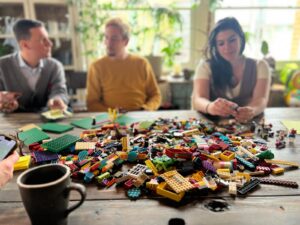
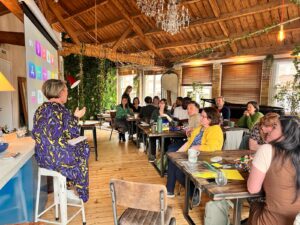
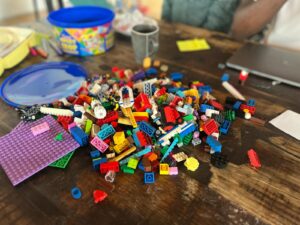
Changing Environments for Inner Balance
A changing environment revitalises our sense of wellbeing. It offers opportunities to gain new perspectives, clarity, and experience the magic of different sensory stimulation. When we're exposed to diverse environments, our minds are challenged to adapt and learn, leading to expanded perspectives and increased mental and physical creativity. The variety of sensory experiences in different environments can stimulate our senses, invigorate our minds, and enhance our overall sense of vitality and presence in the world. This is why, when I can, I get away. Working from home is a gift, but in order to feel alive, I need to travel.
I visited Marrakesh for the first time in April, with the idea of researching a selection of the riads and rooftop restaurants for a future retreat for my community. The narrow, labyrinthine streets of the medina, adorned with colourful textiles, intricate tile work, and every kind and colour of spice, offered a stark contrast to the familiar landscapes of my countryside home. Getting lost in the maze-like alleys became a thrilling adventure in itself, a metaphor for embracing the unknown and relinquishing control (but thank God for Google Maps or I’d still be there!)
Beyond the sensory overload and the allure of the exotic, it was the spiritual nature of Marrakesh that truly resonated with me. Amidst the hustle and bustle of the city, there existed an undeniable sense of tranquility and serenity. I found solace in the quiet corners of the city's many riads, where the sound of trickling fountains and the scent of orange blossom oil filled the air.
In Marrakesh, I found a delicate balance between the tranquility of the traditional Moroccan houses and the vibrant energy of the medina's streets. Each offered its own unique experience, and I came to appreciate the need for both in my life. The peaceful refuge of the riads provided a sanctuary for introspection and reflection, allowing me to recharge and find inner harmony amidst the chaos of the city. Conversely, the bustling streets of the medina ignited my sense of adventure and curiosity, pushing me out of my comfort zone and encouraging exploration. Despite being an introvert, the change of environment excites and rejuvenates me. A typical Libra, I need the balance of both in my life.
If you're seeking guidance in navigating your own journey of self-discovery and personal growth, consider transitional life coaching. Consider changing your environment. Seek the moments where you can find peace amongst the chaos.
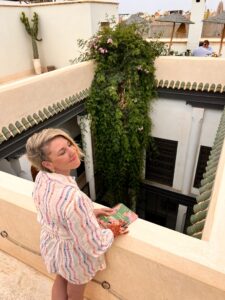


The Farmer & The Stallion
The story of The Farmer and the Stallion is an example of one of my many coaching strategies that draws on ancient wisdom. The story serves as a powerful metaphor which helps you to reflect on acceptance, resilience and how you can face challenging situations with equanimity. It’s one of my favourite tools to use to help the people I work with to find some peace in any situation…
In a tranquil village, there lived a wise farmer known for his philosophical outlook on life. One day, the farmer's prized stallion escaped from its stable, leaving the villagers to express their sympathy. They gathered around him, sharing their condolences for what seemed to be a misfortune.
Remaining composed, the farmer replied, "Who knows what is good, and what is bad." The villagers were puzzled by his response. Days later, the escaped stallion returned, accompanied by a group of wild horses. The villagers, now delighted for the farmer's apparent good fortune, congratulated him on his newfound wealth.
Once again, the farmer calmly responded, "Who knows what is good, and what is bad." As his son attempted to tame the wild horses, he was thrown off and broke his leg. The villagers, returning to offer their sympathy, spoke of the unfortunate turn of events. The farmer, however, retained his composure, repeating, "Who knows what is good, and what is bad."
Soon after, the village found itself in the midst of war, and all able-bodied young men were conscripted. Due to his broken leg, the farmer's son was spared from the harsh realities of the battlefield. The villagers, now understanding the profound wisdom in the farmer's words, recognised that life's twists and turns are not always as they seem.
The story of the farmer and the stallion teaches us about the uncertainty of labelling challenges as strictly positive or negative. It underscores the idea that our initial judgments may not accurately capture the ultimate nature and outcomes of a situation. Here are key lessons:
1. Unpredictability of Outcomes:
The story highlights that what may initially seem like a setback or misfortune can lead to unexpected positive outcomes, and vice versa. It encourages us to be cautious about making definitive judgments about the nature of challenges.
How can you suspend immediate judgments about a current challenge, allowing space for unexpected positive outcomes to emerge over time?
2. Long-Term Perspective:
By repeating the phrase "Who knows what is good, and what is bad," the story prompts us to consider the long-term consequences and benefits of a situation. It discourages hasty labeling and encourages patience in waiting to see how events unfold.
What steps can you take to adopt a more patient and long-term perspective when faced with challenges, resisting the urge to make hasty judgments?
3. Avoiding Assumptions:
The farmer's attitude challenges the assumption that we can accurately predict the future impact of a challenge. It urges us to approach difficulties with an open mind, avoiding rigid assumptions about their inherent positivity or negativity.
In what ways can you challenge assumptions about the inherent positivity or negativity of a situation, fostering a more open-minded approach to understanding its complexities?
4. Mindset of Acceptance:
The story promotes a mindset of acceptance, urging us to acknowledge the uncertainty inherent in life. Instead of resisting challenges or immediately categorising them, it encourages a more open and accepting approach to the ebb and flow of circumstances.
How might incorporating a mindset of acceptance influence your ability to navigate challenges, allowing you to approach them with greater equanimity?
5. Resisting Dualistic Thinking:
The story discourages dualistic thinking where situations are categorized as purely good or bad. It invites us to embrace complexity and recognize that the true nature of events often transcends simplistic binary labels.
What practices can you implement to avoid dualistic thinking and embrace the complexity of situations, recognizing that they often exist on a spectrum rather than in black-and-white terms?
6. Cultivating Equanimity*:
Through the farmer's calm demeanour in the face of both perceived good and bad events, the story teaches us the value of cultivating equanimity – a balanced and composed mindset that doesn't get swayed by the immediate emotional impact of a situation.
What strategies can you employ to cultivate a sense of equanimity, remaining composed and balanced regardless of whether a situation is initially perceived as positive or negative?
* equanimity
3 Japanese Concepts to influence your Headship
As many of you know, I'm an avid traveler, as well as a dedicated advocate for intentional well-being. In my coaching circles, I frequently stress the significance of changing your environment (and booking holidays!) to enhance well-being. Currently, I'm eagerly researching a future trip to Japan. You might be familiar with my discussions on Ikigai, the Japanese concept of 'core purpose,' promoting fulfilment and purposeful living. Its popularity in the West aligns with the pursuit of work-life balance and well-being, mirroring growing self-help trends. Beyond Ikigai, there are other Japanese philosophies worth exploring for enhancing leadership values and personal well-being. Here are three lesser known Japanese concepts to delve into further, which I think are particularly helpful for navigating a values -led headship:
1. Wabi-Sabi 侘び寂び
Wabi-Sabi, a Japanese concept, celebrates imperfection, impermanence, and simplicity's beauty. Integrating it into well-being practices promotes self-acceptance and appreciating the present moment. In headship, embracing Wabi-Sabi involves recognizing unique strengths and imperfections within a team, fostering an environment aligned with the school’s core values for acceptance and growth.
2. Kaizen カイゼン
Rooted in continuous improvement, Kaizen emphasises making small, incremental changes for improvement, or a preferable term, ‘betterment’. Applied to well-being, it encourages consistent, positive habits for long-term improvement. In leadership, Kaizen supports a culture of continuous learning. For school leaders, incorporating Kaizen means nurturing an environment where small, positive changes align with the school’s vision and values, promoting sustained growth and the well-being of the team, including happy teachers!
3. Omotenashi おもてなし
Omotenashi, translated as 'hospitality,' goes beyond mere service, involving anticipating needs and providing heartfelt care. Integrating it into leadership emphasises empathy; genuine concern for team members, and creating an inclusive, supportive work environment. Embracing Omotenashi fosters a culture where hospitality extends to authentically understanding and meeting unique needs, promoting a sense of belonging and well-being among team members, much like our own ideal of inclusive and equitable education.
I hope that sharing these concepts from the Far East will prompt positive reflections on how they can influence your perspective and values-led leadership.
Identifying your Saboteurs
We are all familiar with the concept of Imposter Syndrome. Saboteurs and imposter syndrome share a deep connection as both involve negative thought patterns and self-limiting beliefs. Saboteurs can intensify imposter syndrome by reinforcing feelings of inadequacy and fear of being exposed as a fraud, perpetuating a cycle of self-doubt and anxiety. Sound familiar?!
The impact of the saboteurs on professional and personal growth can be significant. In the professional realm, they can undermine confidence, stifle creativity and lead to missed opportunities and unfulfilled potential. In your personal life, they can affect relationships, diminish self-esteem, and limit your ability to pursue meaningful goals and experiences. None of this is great if you’re pursuing a fulfilling and meaningful lifestyle.
Identifying the saboteurs is crucial for releasing self-limiting beliefs and thriving, in work and in life! By recognising your inner critics, you can raise self-awareness and understand how these thought patterns have been holding you back. Through coaching and intentional personal development, you can challenge these saboteurs, reframe negative thoughts, and cultivate a more positive and empowering mindset. This process allows you to build resilience, embrace your strengths, foster self-compassion and enable you to overcome imposter syndrome and other self-limiting beliefs.
We identify and discuss strategies for slaying these saboteurs in The Life Story Coaching Programme and in the Slay your Saboteurs Programme Slay your Saboteurs Programme. These strategies and techniques help you empower you to ‘slay the saboteurs’ by reframing negative thoughts, embracing self-compassion and applying particular techniques to particular circumstances; whether that’s the dilemmas you’re facing at work, challenges with your self-esteem, or struggles in relationships.
Developing your own toolkit of these strategies enhances your mental resilience, supports personal and professional growth, and helps you to thrive in the face of whatever life throws at you! Whatever comes your way, you’ll know which saboteurs is at play and which strategy to implement to slay it.
You can read more about each saboteur below and take the assessment to discover your own dominant saboteurs here. Each saboteur possesses its distinct charm, tempting us with promises of protection and control, but beneath their allure lies a web of self-limiting beliefs, woven intricately to hold us back from unleashing our true potential….
The Hyper-Achiever Saboteur, driven by relentless ambition, can ensnare us in the shackles of perfectionism and the fear of failure. Its alluring facade of success blinds us to the beauty of imperfection and stifles our creativity, suffocating self-esteem under the weight of unattainable standards. The Hyper-Achiever saboteur instills a fear of failure and an insatiable need for success, leading individuals to doubt their abilities and relentlessly pursue perfection.
The Pleaser Saboteur persuades us that our worth is tied to the approval of others. In its clutches, we surrender our authenticity, tiptoeing around truth, and suppressing our genuine desires to keep the peace, losing ourselves in the process. Suppressing our authentic selves and fostering a constant need for external validation becomes exhausting and we loose a sense of self.
The Hyper-Rational Saboteur, wearing the guise of logic, seeks to sever us from the depths of our emotions. Its denies us the richness of emotional connections and self-compassion. The Hyper-Rational saboteur denies the significance of emotions, often leading to emotional detachment and a sense of disconnection.
The Restless Saboteur beckons us to an unquenchable pursuit of more, leaving us parched with perpetual dissatisfaction. It whispers illusions of fulfilment through external achievements, blinding us to the oasis of contentment. Always seeking more, The Restless saboteur leaves you feeling perpetually unsatisfied and unable to appreciate the present moment.
The Controller Saboteur, with its iron grip, convinces us that control is the only path to security. It tightens its hold with the fear of uncertainty, stunting our ability to embrace the unknown and robbing us of the thrill of life's unpredictable adventures. The Controller saboteur demands absolute control over almost every situation, stifling adaptability and impeding personal growth.
The Avoider Saboteur, a master of evasion, artfully dodges challenges, shielding us from discomfort and growth. Its deceptive promises of temporary relief often blind us to procrastination, leaving our potential untapped and dreams unrealised. The Avoider saboteur traps us in a cycle of avoidance and missed opportunities.
The Victim Saboteur engulfs us in a sea of self-pity and learned helplessness. Its convincing narrative of powerlessness keeps us trapped in the depths of despair, preventing us from seizing control of our lives and owning our own narrative. The Victim saboteur fosters feelings of helplessness and prevents us from taking charge of our lives.
Lastly, the Hyper-Vigilant Saboteur, an ever-watchful sentinel, feeds us a constant stream of anxiety, forecasting doom at every turn. Its incessant worry and anticipation of negative outcomes cripple our confidence and rob us of the peace we deserve.
